Trematochampsa is a dubious extinct genus of crocodyliform from the Late Cretaceous In Beceten Formation of Niger.
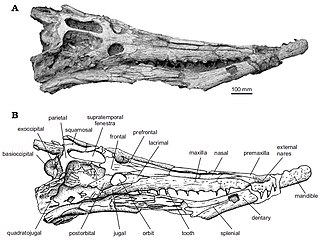
Dyrosauridae is a family of extinct neosuchian crocodyliforms that lived from the Campanian to the Eocene. Dyrosaurid fossils are globally distributed, having been found in Africa, Asia, Europe, North America and South America. Over a dozen species are currently known, varying greatly in overall size and cranial shape. A majority were aquatic, some terrestrial and others fully marine, with species inhabiting both freshwater and marine environments. Ocean-dwelling dyrosaurids were among the few marine reptiles to survive the Cretaceous–Paleogene extinction event.
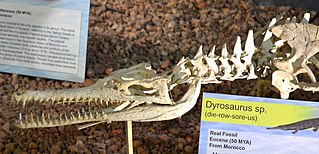
Dyrosaurus is a genus of extinct crocodylomorph that lived during the early Eocene. The name Dyrosaurus comes from sauros (σαῦρος) the Greek for lizard or reptile, and Dyr for Djebel Dyr (mountain) close to where the type species was discovered. It was a large reptile with an estimated body length of 6.5 metres (21 ft).

Peirosauridae is a Gondwanan family of mesoeucrocodylians that lived during the Cretaceous period. It was a clade of terrestrial crocodyliforms that evolved a rather dog-like skull, and were terrestrial carnivores. It was phylogenetically defined in 2004 as the most recent common ancestor of Peirosaurus and Lomasuchinae and all of its descendants. Lomasuchinae is a subfamily of peirosaurids that includes the genus Lomasuchus.
The Farak Formation is a geological formation in Niger, central Africa.

Pholidosauridae is an extinct family of aquatic neosuchian mesoeucrocodylian crocodylomorphs. Fossils have been found in Europe, Africa, North America and South America. The pholidosaurids first appeared in the fossil record during the Bathonian stage of the Middle Jurassic. Jouve & Jalil (2020) described postcranial material of a pholidosaurid from the Paleocene (Danian) of Ouled Abdoun Basin (Morocco), representing the most recent record of the family. The authors also reinterpreted putative Maastrichtian dyrosaurid Sabinosuchus as a pholidosaurid, and argued that at least two independent pholidosaurid lineages reached the Maastrichtian, among which one survived the Cretaceous–Paleogene extinction event. Before the publication of this study it was thought that the family became extinct during the Late Turonian stage of the Late Cretaceous.

Neosuchia is a clade within Mesoeucrocodylia that includes all modern extant crocodilians and their closest fossil relatives. It is defined as the most inclusive clade containing all crocodylomorphs more closely related to Crocodylus niloticus than to Notosuchus terrestris. Members of Neosuchia generally share a crocodilian-like bodyform adapted to freshwater aquatic life, as opposed to the terrestrial habits of more basal crocodylomorph groups. The earliest neosuchian is suggested to be the Early Jurassic Calsoyasuchus, which lived during the Sinemurian and Pliensbachian stages in North America. It is often identified as a member of Goniopholididae, though this is disputed, and the taxon may lie outside Neosuchia, which places the earliest records of the group in the Middle Jurassic.
Brillanceausuchus is an extinct genus of paralligatorid crocodyliforms. Fossils have been found in Early Cretaceous–age rocks of Cameroon. The genus is notable for the position of the secondary choana within its palate. Parts of the pterygoid bones make up the rostral margin of the choana and thus separate it from the palatines, a feature also seen in the more advanced neosuchian suborder Eusuchia. This characteristic was once thought to be characteristic of Eusuchia, but its presence in Brillanceausuchus suggests that the trait is homoplasic, thus making the evolution of the position of the choana within crocodilians more complex than previously thought.
Stolokrosuchus is an extinct genus of crocodyliforms that lived during the Early Cretaceous. Its fossils, including a skull with a long thin snout and bony knobs on the prefrontal, have been found in Niger. Stolokrosuchus was described in 2000 by Hans Larsson and Boubacar Gado. The type species is S. lapparenti. They initially described it as related to Peirosauridae, if not a member of that family. One study has shown it to be related to Elosuchus. However, more recent works usually find Stolokrosuchus to be one of the basalmost neosuchian, only distantly related to the elosuchid or pholidosaurid, Elosuchus. It was a semiaquatic crocodylomorph.
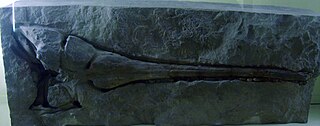
Pholidosaurus is an extinct genus of neosuchian crocodylomorph. It is the type genus of the family Pholidosauridae. Fossils have been found in northwestern Germany. The genus is known to have existed during the Berriasian-Albian stages of the Early Cretaceous. Fossil material found from the Annero and Jydegård Formations in Skåne, Sweden and on the island of Bornholm, Denmark, have been referred to as a mesoeucrocodylian, and possibly represent the genus Pholidosaurus.
Phosphatosaurus is an extinct genus of dyrosaurid crocodylomorph. It existed during the early Eocene, with fossils having been found from North Africa in Tunisia and Mali. Named in 1955, Phosphatosaurus is a monotypic genus; the type species is P. gavialoides. A specimen has been discovered from Niger, but it cannot be classified at the species level.
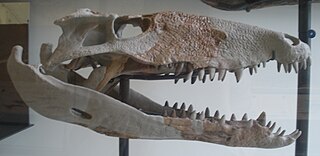
Sebecia is an extinct clade of mesoeucrocodylian crocodyliforms that includes peirosaurids and sebecids. It was first constructed in 2007 to include Hamadasuchus, Peirosauridae, and Sebecus. It was initially considered to be the sister taxon of the clade Neosuchia, which includes living crocodilians, although some later studies have placed it within Neosuchia as a basal clade. Sebecians were terrestrial crocodyliforms characterized by their deep snouts and ziphodont dentition. They first appeared in the Late Cretaceous, survived the Cretaceous–Paleogene extinction event, and became extinct in the Miocene epoch.
Sebecosuchia is an extinct group of mesoeucrocodylian crocodyliforms that includes the families Sebecidae and Baurusuchidae. The group was long thought to have first appeared in the Late Cretaceous with the baurusuchids and become extinct in the Miocene with the last sebecids, but Razanandrongobe pushes the origin of Sebecosuchia to the Middle Jurassic. Fossils have been found primarily from South America but have also been found in Europe, North Africa, Madagascar, and the Indian subcontinent.
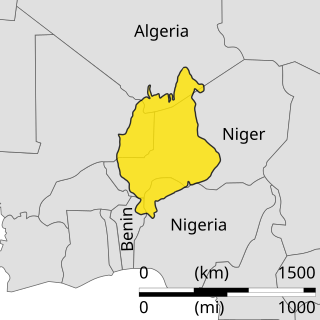
The Iullemmeden Basin is a major sub-Saharan inland basin in West Africa, extending about 1,000 kilometres (620 mi) north to south and 800 kilometres (500 mi) east to west. It covers western Niger and parts of Algeria, Mali and Nigeria. It is named after the Iullemmeden, a federation of Tuareg people who live in the central region of Niger. Its geographic range is largely coincident with the Azawagh region.
Anteophthalmosuchus is an extinct genus of goniopholidid mesoeucrocodylian from the Early Cretaceous of southern England, eastern Spain, and western Belgium.

Tethysuchia is an extinct clade of neosuchian mesoeucrocodylian crocodylomorphs from the late Middle Jurassic to the Early Eocene of Asia, Europe, North America and South America. It was named by the French paleontologist Eric Buffetaut in 1982 as a suborder. Tethysuchia was considered to be a synonym of Dyrosauridae or Pholidosauridae for many years. In most phylogenetic analyses the node Dyrosauridae+Pholidosauridae was strongly supported. De Andrade et al. (2011) suggested that Tethysuchia be resurrected for that node. They defined it as a node-based taxon "composed of Pholidosaurus purbeckensis and Dyrosaurus phosphaticus, their common ancestor and all its descendants". In their analysis they found that the support for Tethysuchia is actually stronger than the support for Thalattosuchia. The following cladogram shows the position of Tethysuchia among the Neosuchia.
Paluxysuchus is an extinct genus of neosuchian crocodyliform known from the Early Cretaceous Twin Mountains Formation of north-central Texas. It contains a single species, Paluxysuchus newmani. Paluxysuchus is one of three crocodyliforms known from the Early Cretaceous of Texas, the others being Pachycheilosuchus and an unnamed species referred to as the "Glen Rose Form". Paluxysuchus has a long, flat skull that is probably transitional between the long and narrow skulls of many early neosuchians and the short and flat skulls of later neosuchians.
Hulkepholis is an extinct genus of goniopholidid mesoeucrocodylian from the Early Cretaceous of southern England and eastern Spain. It contains two species, the type species, Hulkepholis willetti, and also H. plotos. Hulkepholis is most closely related to both species of Anteophthalmosuchus.

Coelognathosuchia is an extinct clade of neosuchian crocodyliforms that includes all taxa more closely related to the family Pholidosauridae than to Bernissartia fagesii or Eusuchia. Martin et al. (2014) named the clade after finding goniopholidids and pholidosaurids to group together in their phylogenetic analysis of crocodyliform evolutionary relationships. In their analysis, Pholidosauridae was monophyletic and Goniopholididae was paraphyletic, being an assemblage of successively more basal taxa within Coelognathosuchia. Coelognathosuchia itself was positioned near the base of the larger clade Neosuchia as the sister group to a clade containing the Early Cretaceous neosuchian Bernissartia and Eusuchia, the group that includes all modern crocodilians and their closest extinct relatives.
Fortignathus is an extinct genus of dyrosaurid or peirosaurid crocodylomorph known from the Late Cretaceous Echkar Formation in Niger. It contains a single species, Fortignathus felixi, which was originally named as a species of Elosuchus in 2002.













